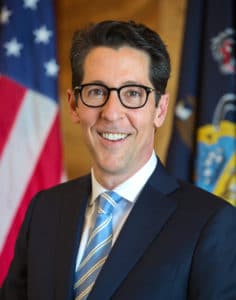
By Joe Torsella, Pennsylvania State Treasurer

The weakening of the pillars supporting retirement security (Social Security, employer-provided pension plans, and supplemental retirement and other savings plans) is one of the greatest fiscal and economic challenges we face today. Almost half of our private sector workforce — approximately 2.1 million Pennsylvanians in our state alone — lacks access to retirement savings plans through their employers. A readily available workplace retirement savings plan dramatically increases the likelihood that workers will begin to save for retirement. Leaving more than 40 percent of our workers without the opportunity to access simple, low-cost ways to save for their future security will exact a heavy toll on the economic and fiscal future of our state.
In October 2017, I convened a Task Force on Private Sector Retirement Security to assess the situation nationally and in Pennsylvania, and to explore solutions that could improve outcomes for employers and workers in our state. The Task Force held four hearings across the state between October 2017 and February 2018. What we have learned should serve as a call to action.
An Aging Pennsylvania
Pennsylvania’s population is one of the oldest in the nation, and will get even older over the next two decades. The median age of Pennsylvania residents today is 40.7, compared to 37.9 nationwide, making us the seventh-oldest state in the nation. In 2015, 17 percent of residents were 65 or older. This figure is expected to increase by 42 percent, from 2.2 million in 2015 to 3.1 million in 2030, driven by the fact that our near-retiree age group (50–64 years old) already makes up 21 percent of the state’s population. According to data from the Pennsylvania Independent Fiscal Office (PA-IFO), the growth of our state’s population from 2017 to 2025 will be driven by a 23 percent rise in the size of the population aged 65 and older, while the size of the population under age 64 will actually decline during this same period. The largest increases in the elderly population between the years 2015–2030 will be among those 75–84 years old.
The aging of the population is driven by two trends: the increase in the number of Americans turning 65 (between now and 2030, 10,000 baby boomers will retire every day in the U.S.) and the fact that more Americans are living longer. Today, a man turning 65 can expect to live, on average, until age 84, with one-quarter of those turning 65 today expected to live until age 90 and 10 percent projected to live past age 95, according to the U.S. Social Security Administration.
A Lack of Retirement Readiness
Like much of the country, Pennsylvania employees have experienced a shift from traditional defined benefit (DB) pension plans to defined contribution (DC) retirement savings plans and, with this shift, a decline in retirement readiness. While a traditional DB plan provides a worker a guaranteed income at retirement, a DC plan puts the responsibility fully on the employee to make the decisions about whether and how much to save, with no guarantee or promise that the resulting account balance will be adequate at the time of retirement.
According to the National Institute for Retirement Security (NIRS), the shift away from DB plans to DC plans means that younger households today are half as likely to have a DB plan as current and near-retirees. Although Pennsylvania has had a slightly higher proportion of its elderly funding their retirement with traditional DB pension plans than the national average, only one-half of Pennsylvania workers participated in a retirement plan at work in 2012, a decrease from 58 percent in 2000. Among workers in their 40s who have saved in a DC account, the average savings balance was only $40,719. This sum is clearly inadequate, given that the average annual earnings for Pennsylvanians in 2012 was $61,240 and financial experts recommend that by that point in their lives, workers should have already amassed two to three times their salary in retirement accounts.
Each year, more and more of those age 65 and older are remaining in the workforce, in part because their financial fragility has increased significantly. Between 1997 and 2017, the labor force participation rate for those over age 65 has almost doubled, from 10 percent to 20 percent, and has been increasing faster than the national growth rate, according to PA-IFO. Between 2003 and 2015, the growth in level of debt carried by those older than age 65 increased by more than 40 percent, with more than three-quarters in the form of housing debt. Worse, the debt level doubled for those age 75 and older. Our older residents are carrying greater financial burdens, and for much longer, than ever before.
Significant Pressure on State Budget and Programs
Recognizing that a lack of retirement savings will have very real consequences for our state budget and programs, we commissioned a unique study by Econsult Solutions that examined the fiscal impact of insufficient retirement savings on the demand for state programs. The level of income of the elderly directly affects means-tested public assistance programs, including medical services and long-term care. Medical costs, which make up three-quarters of state assistance to the elderly, are estimated to rise 21 percent faster than inflation from 2015 through 2030. This means the costs to the state of providing a consistent level of medical services will increase in real dollar terms and, at the household level, spending for other items, such as mortgage/rent, automotive, vacation, utilities, and food, will be displaced or constrained to offset increased medical costs.
The Econsult study estimated state assistance costs for elderly residents at $4.2 billion in 2015, with 54 percent of the cost tied to the 21 percent of the population with $20,000 or less in annual household income and 83 percent tied to the half of the population earning $40,000 or less in 2015. The annual net state assistance costs stemming from insufficient savings — defined as the failure to maintain 75 percent of pre-retirement income — in elderly households is estimated to be $700 million. This figure is projected to rise to $1.1 billion by 2030, with a cumulative cost of $14.3 billion over that period if there is no policy action. (These estimates do not account for programs that are exclusively federally funded, such as SNAP, or programs funded by local governments.)
The challenges of paying for these services are compounded by the fact that there will be fewer workers age 20 to 64 for each person age 65 and older. This ratio — known as the age dependency ratio — was 3.9 in 2010 and is projected to drop to 2.4 by 2030. This shift will place additional pressure on state budgets and the sources of tax revenue.
The Impact on Economic Growth
Because elderly households will make up a greater proportion of the population in the future, their spending patterns will have a greater impact on the state’s economy. According to the Econsult study, lost household spending due to insufficient savings was estimated to be $2 billion in 2015 and to reach $3.1 billion by 2030, with a cumulative loss of $40 billion from 2015–2030.
Any shortfall in household spending has a direct effect on economic activity in the state. In 2015, lost economic output from reduced spending was estimated at $2.8 billion (representing a loss of more than 20,000 full-time equivalent jobs and more than $850 million in employee earnings) and is projected to be $4.3 billion by 2030, with a cumulative $55 billion in lost economic benefits from 2015–2030. This loss of economic activity also reduced the state’s tax revenue from earnings for employees and businesses that are subject to income and corporate taxes by an estimated $70 million in 2015, and is expected to reach $106 million in 2030, with a cumulative loss of $1.4 billion in state tax revenue from 2015–2030.
Conclusion
The financial future for Pennsylvania will be threatened unless today’s leaders are willing to confront the realities of an aging population that is living longer, but is increasingly financially fragile. The demands of today’s elderly poor are already very costly, and it’s clear that a “silver tsunami” is on the horizon in the next two decades. We are not prepared to weather this storm unless we act now to protect our future.
Several states, such as Oregon, California, Illinois, Maryland, Connecticut, Vermont, and Washington, have already taken steps to expand access to simple, low-cost ways to save for those private sector workers who lack access to an employer-sponsored retirement savings plan. Support for these innovative state programs among employees and employers is strong and bipartisan. The more than 2 million residents of Pennsylvania who currently lack access deserve similar consideration. We must learn from what these states have already done and take similar action in Pennsylvania.
Joe Torsella is Treasurer of the Commonwealth of Pennsylvania and a member of the Georgetown University Center for Retirement Initiatives’ Council of State Advisors.
March 2018, 18-04
Additional Resources
AARP, “Fact Sheet: Pennsylvania – Workplace Retirement Plans Will Help Workers Build Economic Security,” August 2015.
Econsult Solutions, “The Impact of Insufficient Retirement Savings on the Commonwealth of Pennsylvania,” January 25, 2018.
Georgetown University Center for Retirement Initiatives, “State-Facilitated Retirement Savings Programs: A Snapshot of Plan Design Features (18-03),” March 1, 2018.
National Institute on Retirement Security, “Financial Security for Future Retirees: Pennsylvania Scores 6 out of 10,” July 2015.
National Institute on Retirement Security, “State-Facilitated Retirement Savings Plans: Overwhelmingly Supported by Americans,” 2017.
Pennsylvania Independent Fiscal Office, “Aging and the Pennsylvania Economy,” presentation to the Task Force on Private Sector Retirement Security, January 25, 2018.
